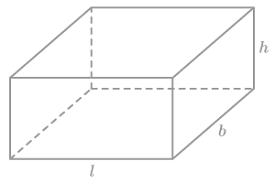
 Data Structure
Data Structure Networking
Networking RDBMS
RDBMS Operating System
Operating System Java
Java MS Excel
MS Excel iOS
iOS HTML
HTML CSS
CSS Android
Android Python
Python C Programming
C Programming C++
C++ C#
C# MongoDB
MongoDB MySQL
MySQL Javascript
Javascript PHP
PHP
- Selected Reading
- UPSC IAS Exams Notes
- Developer's Best Practices
- Questions and Answers
- Effective Resume Writing
- HR Interview Questions
- Computer Glossary
- Who is Who
Haskell Program to Find the Surface area and Volume of Cuboid
This tutorial discusses writing a program to find the Surface area and volume of a cuboid in the Haskell programming language.
A cuboid is a solid shape that has six rectangular faces. A cuboid has three dimensions length, breadth, and height. The surface area of a cuboid is the total area of the six rectangular faces i.e 2*length*breadth + 2*length*height + 2*breadth*height. The volume of the cuboid is length*breadth*height. As volume is area*height.

In this tutorial we see,
- Program to find the surface area of a cuboid.
- Program to find the volume of a cuboid.
Algorithm Steps
- Take input or initialize the variables.
- Implement the program logic to compute the surface area and volume of the cuboid.
- Print or display the surface area and volume.
Example 1
Program to find the surface area of a cuboid.
-- function declaration
surfaceArea :: Float->Float->Float->Float
-- function definition
surfaceArea a b h = 2*a*b + 2*a*h + 2*b*h
main = do
-- declaring and initializing variables
let a = 5
let b = 4
let h = 3
-- computing the surface area
let area = surfaceArea a b h
-- printing the surface area
print ("The surface area of a cuboid with length, breadth, and height as " ++ show a ++ ", "++show b ++ ", and " ++ show h ++" is:")
print (area)
Output
"The surface area of a cuboid with length, breadth, and height as 5.0, 4.0, and 3.0 is:" 94.0
In the above program, we declared a function surfaceArea as such it takes three floats as arguments and returns a float. In its function definition, three arguments are accepted a, b, and h. Where a, b, and h are length, breadth, and height respectively. The surface area is computed and returned. In the main function, three variables for length, breadth, and height of the cuboid a, b, and c are declared and initialized with values 5, 4, and 3 respectively. The function surfaceArea is invoked with these initialized variables as arguments. As this function returns the surfaceArea of the cuboid, the returned output is loaded into a variable area. Finally, the surface area of the cuboid is printed with the print function.
Note ? The function show takes the argument of a number and returns the parsed string of a number. "++" is an operator to concatenate strings in Haskell.
Example 2
Program to find the volume of a cuboid.
-- function declaration
volume :: Float->Float->Float->Float
-- function definition
volume a b h = a*b*h
main = do
-- declaring and initializing variables
let a = 5
let b = 4
let h = 3
-- computing the volume
let vol = volume a b h
-- printing the volume
print ("The volume of a cuboid with length, breadth, and height as " ++ show a ++ ", "++show b ++ ", and " ++ show h ++" is:")
print (vol)
Output
"The volume of a cuboid with length, breadth, and height as 5.0, 4.0, and 3.0 is:" 60.0
In the above program, we declared a function volume as such it takes three floats as arguments and returns a float. In its function definition, three arguments are accepted a, b, and h. Where a, b, and h are length, breadth, and height respectively. The volume is computed and returned. In the main function, three variables for length, breadth, and height of the cuboid a, b, and c are declared and initialized with values 5, 4, and 3 respectively. The function volume is invoked with these initialized variables as arguments. As this function returns the volume of the cuboid, the returned output is loaded into a variable vol. Finally, the surface area of the cuboid is printed with the print function.
Conclusion
In this tutorial, we discussed implementing programs to find the surface area and volume of the cuboid in the Haskell programming language.

